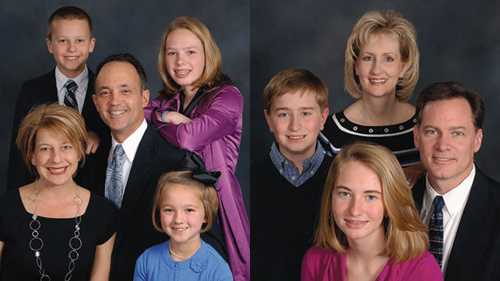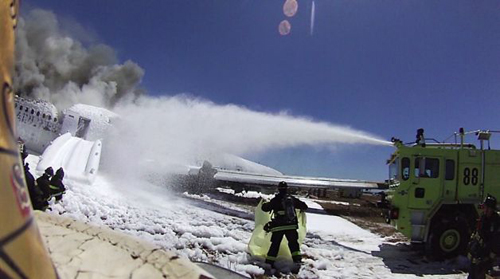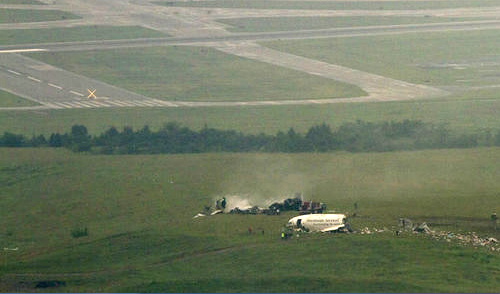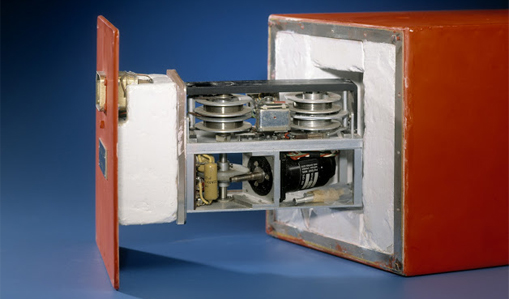UPS Airlines Flight 1354
On August 14, 2013 UPS Airlines Flight 1354 departed from Louisville International Airport and was scheduled to arrive just before dawn at Birmingham-Shuttlesworth International Airport. A typical cargo flight became a fiery crash, clipping trees and a utility line before impacting the terrain just North of Birmingham’s runway 18.

Boeing 777 Autothrottle
San Jose’s NBC affiliate is reporting that a “trap” in the Flight Level Change mode (FLCH) of the plane’s autothrottle system may have contributed to the July 6 crash. According to the report, the “trap” exists if a pilot is using the Flight Level Change mode to decrease altitude during a final descent. At some programmed altitude point, the engines go into an “idle” mode. Then, in a last minute emergency, if the plane is in FLCH mode and the pilot tries to quickly use the autothrottle to add power, it won’t add any power to the idle engine.

16-year-old Ye Meng Yuan was killed following the crash of Asiana 214
中国版本 Chinese Version Asiana Airlines has offered $10,000 to each of the surviving passengers of the July 6 crash of flight 214 in San Francisco. Asiana spokeswoman Lee Hyomin said the proposed payout is not a settlement and accepting the money does not prevent passengers from suing the airline.
“There could be situations when the money is urgently needed and this could reduce inconveniences.”
According to an article in the English version of the Korean Yonhap News Agency, Asiana has proposed eight conditions for passengers to receive the compensation, which include an article apparently making it difficult for passengers to make lawsuits, raising concerns of more legal disputes down the road.

The Antonakos and McManus Familes (Photos: Christ Church Episcopal, Greenville, SC)
Without a Flight Data Recorder or a Cockpit Voice Recorder and no eyewitnesses, NTSB investigators didn’t offer many new details in their preliminary report regarding the July 7 Soldotna plane crash which killed 2 South Carolina families and the pilot.
Owner and pilot Walter “Willy” Rediske’s De Haviland DHC-3 Otter crashed on the runway soon after takeoff from the Soldotna airport. Two vacationing families from Greenville, SC were on board and had chartered the plane for a flight to Bear Mountain Lodge off Alaska’s Chinitna Bay.

SF firefighter helmet cam video shows covering the body of Ye Meng Yuan (SFFD)
中国语文 Chinese Version In an unfortunate apparent reaction to the tragic accidental killing of Asiana flight 214 16-year-old passenger Ye Meng Yuan, San Francisco Fire Department Chief Joanne Hayes-White has banned helmet video cameras from emergency scenes. It was footage from Fire Battalion Chief Mark Johnson’s helmet camera that confirmed that fire trucks had run over the injured passenger during the July 6 emergency response at San Francisco International Airport. Hayes-White said that she was concerned that filming the scene may have violated both firefighters’ and victims’ privacy. She added that Johnson had been interviewed regarding the filming possibly violating fire department policy.

UPS 1394 Short of Runway 18, Birmingham-Shuttlesworth Airport Photo: Butch Dill (AP)
“You have to realize that hill is there or you could come in too low.”
A flight safety spokesman told Reuters that landing at Birmingham-Shuttlesworth Airport can be tricky “because it is nestled among hills and that is especially true of Runway 18.” Kevin Hiatt, president and CEO of the Flight Safety Foundation told Reuters’ Birmingham-based journalist Verna Gates that a “full instrument” landing (autopilot) was not highly advisable at Birmingham-Shuttlesworth Airport.
The UPS Airbus A300 cargo plane with two crew members aboard reportedly clipped trees as it approached the runway before crashing into a hill just short of Runway 18.

Black Box Prototype, 1958
Trans Australia Airlines flight 538 and the first Black Box, 1960
The information recorders in a modern cockpit consist of 2 types of recorders. The Cockpit Voice Recorder (CVR) and the Flight Data Recorder (FDR). The first prototype of the the coupled FDR/CVR was developed in Australia during the 1950s. Although at first slow to recognize the importance of Australian scientist Dave Warren’s invention, after the 1960 crash of Trans Australia Airlines flight 538, the Australian government became the first country in the world to make cockpit-voice recording compulsory.











